
The goatfishes are perciform fish of the family Mullidae. The family is also sometimes referred to as the red mullets, which also refers more narrowly to the genus Mullus.

Triglidae, commonly known as gurnards or sea robins, are a family of bottom-feeding scorpaeniform ray-finned fish. The gurnards are distributed in temperate and tropical seas worldwide.

The European sprat, also known as bristling, brisling, garvie, garvock, Russian sardine, russlet, skipper or whitebait, is a species of small marine fish in the herring family Clupeidae. Found in European waters, it has silver grey scales and white-grey flesh. Specific seas in which the species occurs include the Irish Sea, Black Sea, Baltic Sea and Sea of the Hebrides. The fish is the subject of fisheries, particularly in Scandinavia, and is made into fish meal, as well as being used for human consumption. When used for food it can be canned, salted, breaded, fried, boiled, grilled, baked, deep fried, marinated, broiled, and smoked.
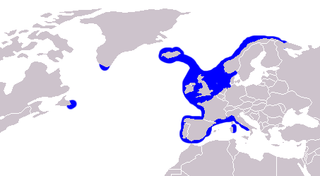
The common ling, also known as the white ling or simply the ling, is a large member of the family Lotidae, a group of cod-like fishes. It resembles the related rocklings, but it is much larger and has a single barbel. This species is unrelated to the pink ling, Genypterus blacodes, from the Southern Hemisphere. The common ling is found in the northern Atlantic, mainly off Europe, and into the Mediterranean Basin. It is an important quarry species for fisheries, especially in the northeastern Atlantic, although some doubts exist as to the sustainability of the fisheries. As an edible species, it is eaten fresh, frozen, or dried, but also preserved in lye, while the roe is a delicacy in Spain.

The North Pacific hake, Pacific hake, Pacific whiting, or jack salmon is a ray-finned fish in the genus Merluccius, found in the northeast Pacific Ocean from northern Vancouver Island to the northern part of the Gulf of California. It is a silver-gray fish with black speckling, growing to a length of 90 cm (3 ft). It is a migratory offshore fish and undergoes a daily vertical migration from the surface to the seabed at depths down to about 1,000 m (3,300 ft). It is the object of an important commercial fishery off the West Coast of the United States, and annual quotas are used to prevent overfishing.
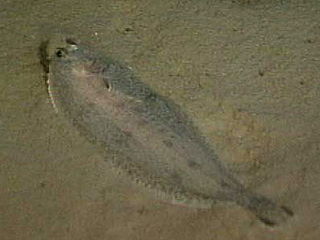
The witch, known in English by a variety of other common names including the witch flounder, pole flounder, craig fluke, Torbay sole, and grey sole, is a species of flatfish from the family Pleuronectidae. It occurs on both sides of the North Atlantic Ocean on muddy sea beds in quite deep water. In northern Europe it has some importance in fisheries as a food fish.

The striped red mullet or surmullet is a species of goatfish found in the Mediterranean Sea, eastern North Atlantic Ocean, and the Black Sea. They can be found in water as shallow as 5 metres (16 ft) or as deep as 409 metres (1,342 ft) depending upon the portion of their range that they are in. This species can reach a length of 40 centimetres (16 in) SL though most are only around 25 centimetres (9.8 in). The greatest recorded weight for this species is 1 kilogram (2.2 lb). This is a commercially important species and is also sought after as a game fish.
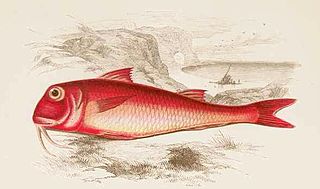
Mullus is a subtropical marine genus of perciform fish of the family Mullidae (goatfish) and includes the red mullets, occurring mainly in the southwest Atlantic near the South American coast and in the Eastern Atlantic including the Mediterranean and the Black Sea. These fish are benthic and can be found resting and feeding over soft substrates.

The red porgy, or common seabream, is a species of marine ray-finned fish in the family Sparidae. It is found in shallow waters on either side of the Atlantic Ocean, being present on the western coast of Europe and the Mediterranean Sea as well as the eastern coasts of North and South America and the Caribbean Sea. It feeds on or near the seabed and most individuals start life as females and later change sex to males.

The piper gurnard, also known as the piper or the lyre gurnard, is a species of marine, demersal ray-finned fish from the family Triglidae, the gurnards and sea robins. It is found in the eastern Atlantic Ocean and the Mediterranean Sea. It is the only species in the monotypic genus Trigla.

The European pilchard is a species of ray-finned fish in the monotypic genus Sardina. The young of the species are among the many fish that are sometimes called sardines. This common species is found in the northeast Atlantic, the Mediterranean, and the Black Sea at depths of 10–100 m (33–328 ft). It reaches up to 27.5 cm (10.8 in) in length and mostly feeds on planktonic crustaceans. This schooling species is a batch spawner where each female lays 50,000–60,000 eggs.
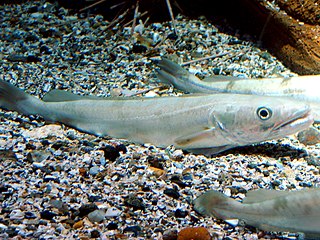
Merluccius merluccius, the European hake, is a merluccid hake of the genus Merluccius. Other vernacular names include Cornish salmon and herring hake. It is a predatory species which was often netted alongside one of its favoured prey, the Atlantic herring, thus the latter common name. It is found in the eastern Atlantic from the Norway and Iceland south to Mauritania and into the Mediterranean Sea. It is an important species in European fisheries and is heavily exploited with some populations thought to be being fished unsustainably.

Merluccius capensis is a ray-finned fish in the genus Merluccius, found in the south-eastern Atlantic Ocean, along the coast of South Africa. It is a long, lean fish with a large head, similar in appearance to the European hake and the deep-water Cape hake. By day, it lives close to the bottom on the continental shelf and upper slope at depths not usually exceeding 400 m (1,300 ft); it makes a large, daily vertical migration rising at night to feed in the nectonic zone, and it also migrates southwards in spring and northwards in autumn. It is an important commercial fish species in southern Africa.

The Mediterranean horse mackerel, also known as the Black Sea horse mackerel, horse mackerel, Mediterranean scad, common scad, or simply scad, is a species of mackerel in the family Carangidae found in the eastern Atlantic from Bay of Biscay to Mauritania, including the Mediterranean Sea. It is a benthopelagic, subtropical, marine fish that can reach up to 60 cm (24 in) in length. In the countries near the Mediterranean and Black Seas, it makes up a significant portion of fish catch, 54% of fish caught in the latter. Despite overfishing in the 1980s, catch numbers have leveled out and it is listed as least concern by the International Union for Conservation of Nature.

Menticirrhus americanus, the southern kingfish, southern kingcroaker, king whiting, Carolina whiting, sea mullet, roundhead, or whiting, is a species of marine fish in the family Sciaenidae. It lives in shallow coastal waters on the western fringes of the Atlantic Ocean.
The Panama hake, also known as the dwarf hake, is a merluccid hake found off the west coast of the Americas from Del Mar, California, to Ensenada de Tumaco, Colombia.
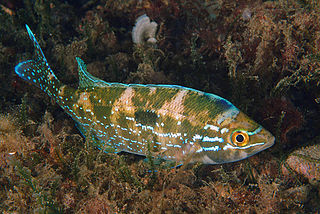
Spicara maena, the blotched picarel, is a species of ray-finned fish native to the eastern Atlantic Ocean, the Mediterranean Sea and the Black Sea. The male grows to a maximum length of about 25 cm (10 in), and the female reaches 21 cm (8 in). This fish is fished commercially in some areas.
Merluccius polli, the Benguela hake, is a species of fish from the family Merlucciidae, the true hakes. It is found in the tropical waters of the eastern Atlantic Ocean off the west coast of Africa.
Merluccius senegalensis, the Senegalese hake, is a species of fish from the family Merlucciidae, the true hakes. It is found in the sub tropical waters of the eastern Atlantic Ocean off the north western coast of Africa.

Triglinae is a subfamily of demersal, marine ray-finned fishes, part of the family Triglidae, the gurnards and searobins. These gurnards are found in all the tropical and temperate oceans of the world except for the Western Atlantic Ocean.


















